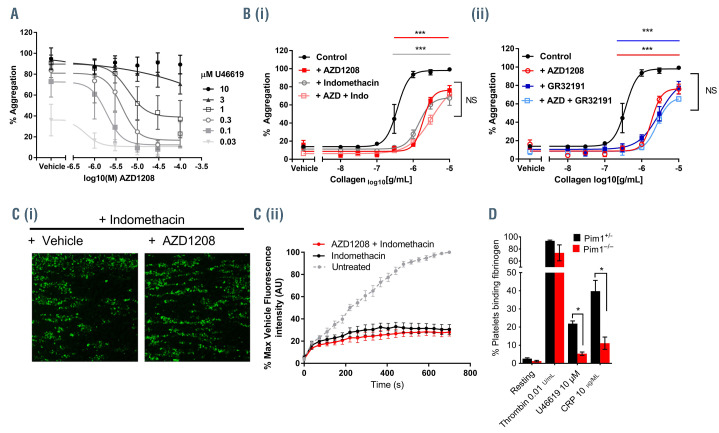Figure 4.
Inhibition of thromboxane A2 signaling underlies inhibition of collagen-induced aggregation and thrombus formation by Pim kinase inhibitors. (A, B) Human washed platelets were treated with (A) increasing concentrations of AZD1208 (1-100 μM) or vehicle control prior to stimulation with increasing concentrations of U46619 (0.03-10 μM) or (B) 10 μM AZD1208 in the presence or absence of (i) indomethacin (10 μM) or (ii) the thromboxane A2 receptor antagonist GR32191 (100 nM). Platelet aggregation was monitored after 5 min of stimulation by collagen (0.01-10 μg/mL) using a 96-well plate based aggregometry assay. (C) DiOC6 loaded human whole blood was pretreated with vehicle (black) or 100 μM AZD1208 (red), in the presence of 10 μM indomethacin for 10 min before perfusion through collagen coated (100 μg/mL) Vena8Biochips at a shear rate of 20 dyn/cm2. Thrombus formation was determined over 10 min by comparing fluorescence intensity in the vehicle and treated samples. (i) Representative images taken at 10 min. (ii) Data expressed as the percentage of maximum fluorescence of vehicle treated cases and normalized to an untreated (no indomethacin treatment) control, where the maximum fluorescence observed in untreated platelets is considered to be 100% thrombus formation. (D) Fibrinogen binding in washed platelets from control (Pim1+/-) or Pim1-/- mice was determined following stimulation with thrombin (0.01 U/mL), U46619 (10 μM) or CRP (10 μg/mL) and expressed as percentage of positive cells. Results are mean + standard error of mean for n≥3, *P≤0.05 ***P≤0.005 in comparison to vehicle control; where normalized data are shown, statistics were performed prior to normalization.

